Accounts
Overview
Sugar's Accounts module consists of companies with whom your organization has a relationship. It is generally seen as the hub for managing and analyzing your business' interactions with each company. Each account record may then relate to other Sugar records such as contacts, meetings, cases, opportunities, and many others as your relationship with the customer matures. This documentation will cover information and actions specific to the Accounts module. For instructions concerning views and actions which are common across most Sugar modules, such as creating, editing, and deleting accounts, please refer to the Working With Sugar Modules section of this page.
Please note that you will only be able to see account records as allowed by your team membership, user access type, and assigned roles. For more information on teams and roles, please refer to the Team Management and Role Management documentation in the Administration Guide.
Account Fields
The Accounts module contains a number of stock fields that come out-of-the-box with Sugar. For information on using and editing various field types, refer to the User Interface documentation. The definitions below are suggested meanings for the fields, but the fields can be leveraged differently to best meet your organization's needs. Administrators or users with developer-level role access have the ability to alter, add, or remove fields via Admin > Studio. For more information on configuring fields, please refer to the Studio documentation in the Administration Guide.
| Field | Description |
| Alternate Phone | The account's alternate phone. If an admin has turned on the Enable Click-to-Call setting in Admin > System Settings, phone number fields are displayed as links that can be opened to dial them using the default computer telephony integration software on the user's computer. For Sugar Serve users logged in to Amazon Connect, calls are dialed in SugarLive. |
| Annual Revenue | The company's annual revenue. |
| Assigned To | The Sugar user assigned to the account. |
| Billing Address | The account's billing address. |
| Business Center Name |
The business center responsible for managing this account. New cases inherit their account's business center which is then used for SugarBPM business hour calculations. For more information, refer to the Business Centers and Accounts section of this page. Leads' business centers are used for SugarBPM business hour calculations during lead routing. For more information, refer to the Stock SugarBPM Templates documentation. |
| Campaign 1 | The campaign, if any, from which the account originated. |
| Comment Log | A shared log of messages, comments, or other text, including the name of the user that added the log entry and the date and time it was added. It is possible to tag other users and link to other Sugar records in Comment Log entries by inserting a clickable pill; see the User Interface documentation for more details. |
| Copy Address From Left | Select the box to copy the account's billing address to the shipping address field. |
| Date Created | The date the account record was created. |
| Date Modified | The date the account record was last modified. |
| Date of Next Renewal |
For instances using revenue line items, the Date of Next Renewal will show the earliest expected close date from all of the account's related revenue line items that meet the following criteria:
For more information on renewable services, refer to the Opportunities documentation. Please note that this field is hidden from views by default and must be added by an administrator via Studio. |
| Description | A description or other information about the account. |
| DUNS | The unique 9-digit number associated with the company in D&B. |
| Email Address | The account's email address. |
| Employees | The number of employees at the company. |
| Escalated | Displayed as a red badge with the text "Escalated" beside the record name in the header and at the top of the preview, this field indicates if the record has an open escalation related to it. If the record is not escalated, the badge is not visible. This field can also be added to other views. See the Escalations page for more details on escalating records. |
| Facebook Account | The account's Facebook account information. |
| Fax | The account's fax number. |
| Google Plus ID | The account's Google Plus ID. |
| Industry | The industry type to which the company belongs. |
| Integration Sync ID | The sync key field used by external integrations to identify Sugar records in the external application. See the Integrate REST API endpoints in the Developer Guide for more details on how to use this field. |
| Name | When viewing, the account's name. |
| Office Phone | The account's office number. If an admin has turned on the Enable Click-to-Call setting in Admin > System Settings, phone number fields are displayed as links that can be opened to dial them using the default computer telephony integration software on the user's computer. For Sugar Serve users logged in to Amazon Connect, calls are dialed in SugarLive. |
| Ownership | Indicate if the company is privately or publicly owned. |
| Member Of | Designate a parent-child relationship between the account and another account in Sugar. |
| Rating | The rating for the company compared to other companies in Sugar. |
| Service Level | The contractual level of service (e.g., Tier 1, Tier 2) for the account which, for Sugar Serve and Enterprise, is used by the stock SugarBPM template to calculate case follow-up dates. |
| Shipping Address | The account's shipping address. |
| SIC Code | The Standard Industrial Classification (SIC) code for the account. |
| Tags | User-created keywords that can be used to identify records in filters, dashlets, and reports. Note: For more information on creating and using tags, please refer to the Tags documentation. |
| Teams | The Sugar team(s) assigned to the account record. |
| Ticker Symbol | The stock trading symbol for the company. |
| Twitter Account | The account's Twitter account information. |
| Type | The account type (e.g., customer, investor, etc.). |
| Website | The website URL associated with the account. |
1 This field's value is not visible to Sugar Serve users; when this field appears on layouts, users without a supported license type will see a placeholder containing the text "License Required" instead of the field's value. See the User Management page for more details on license types.
Escalations and Accounts
The Escalations module is used to track the escalation of a specific record, such as an account. Use the Escalate option in the account's record view Actions menu to create an escalation for the account. As long as the account has at least one open escalation in its Escalations subpanel, the Escalated field is displayed as a red badge with the text "Escalated" at the top of record view and the preview. It can also be displayed in the Record View dashlet and list view.
In addition to the Escalations subpanel, the Accounts module has a second subpanel containing escalation records, called "Other Related Escalations"; these two subpanels are used to represent two different relationships between an account and an escalation. The Escalations subpanel contains all escalations with the Related To field set to the currently viewed account (i.e., a one-to-many relationship), whereas the Other Related Escalations subpanel contains all escalations with this account in their Accounts subpanel (i.e., a many-to-many relationship).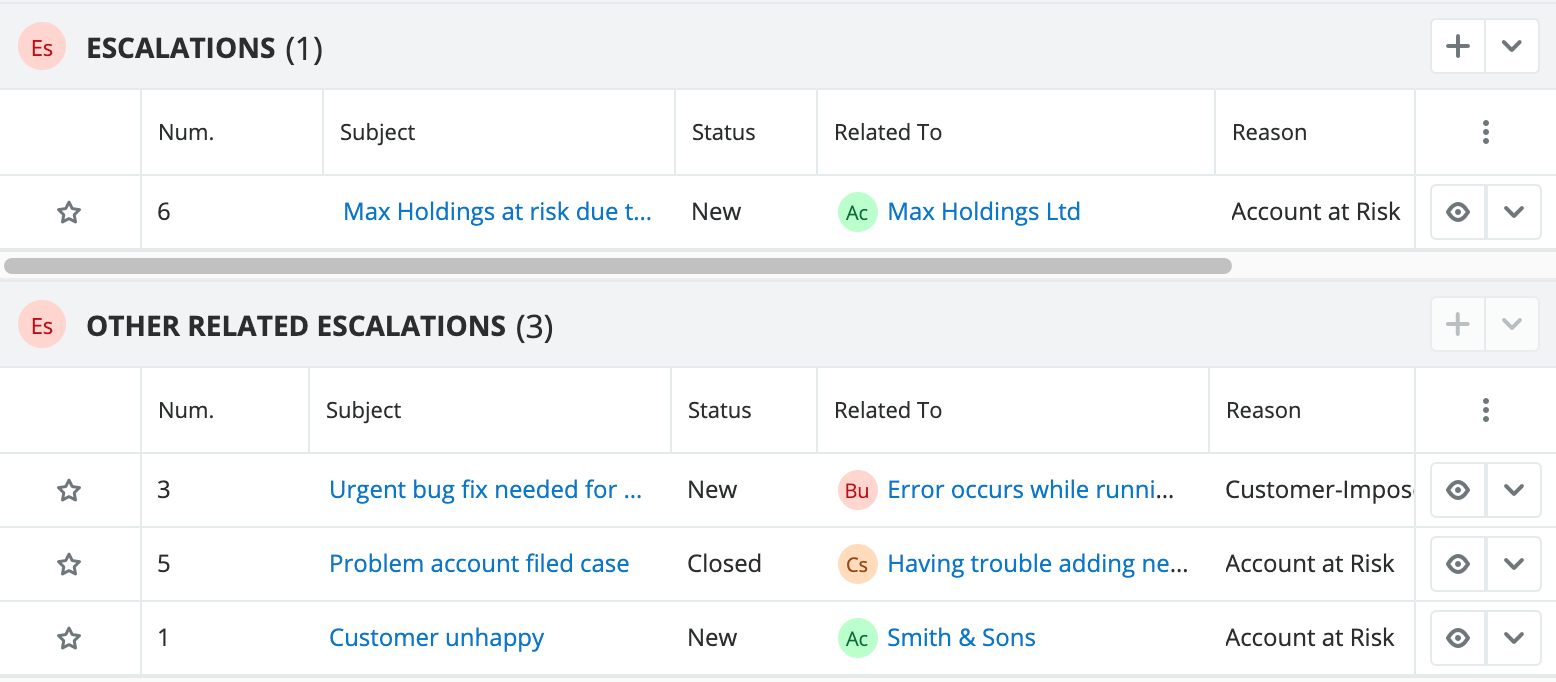
When an escalation is created for an account, case, or opportunity, the related account (i.e., the value of the account's Member Of field or the case or opportunity's Account Name field) is added to the Accounts subpanel on the escalation automatically when the escalation is saved. This means that that escalation will also appear in the account's Other Related Escalations subpanel automatically. Note that if the escalation is then updated to target a different record with a related account, the new account is added but the previous account is not removed.
The following example illustrates the use of the one-to-many and many-to-many escalation relationships: an account may be escalated because the account is at risk of terminating its contract. At the same time, the account may be invested or interested in the escalation of a particular bug that has greatly impacted its users. The account-at-risk escalation would be displayed in the Escalations subpanel because the account itself is escalated. The bug escalation would be displayed in the Other Related Escalations subpanel because the account is not the record that is escalated, but it does need to be related to the bug escalation indirectly; this allows the person working on the bug escalation to be fully aware of how many customers are impacted and may require communication as progress is made.
While the Related Type field is not displayed by default in the Other Related Escalations subpanel, you can enable it using the three-dots menu on the right side to easily see and sort by the type of record that is escalated. See the Escalations page for more details on how escalations work.
Business Centers and Accounts
Business centers represent your company's centers of operation and specify a time zone, operating hours, and holidays so that a concept called "Business Hours" can be leveraged in SugarBPM. Each account's selected business center can be used for SugarBPM business hour calculations.
Sugar Enterprises's stock SugarBPM template uses each case's business center which is inherited from the case's account at the point of creation. For more information, refer to the Cases documentation. If your organization does not wish to specify various business centers on accounts and cases, the stock templates can be modified to use a static business center. Refer to the Getting Started With SugarBPM for Sugar Serve and Stock SugarBPM - Case Follow-Up Date Management articles for help configuring the stock template and your instance to work together.
Sugar Enterprise's stock lead-routing SugarBPM template uses each account's business center for task due-date calculations using business hours. For more information, refer to the Stock SugarBPM Templates documentation.
Once business centers have been set up by an admin or Business Center Administrator, users can simply select the appropriate business center in the Business Center Name field on the account record. For more information on creating and configuring business centers, refer to the Business Center Management documentation.
Emails and Accounts
Accounts include an email address that can be used to email the account as a recipient. The methods for doing so are covered in the Emailing Records section of the User Interface documentation. Accounts may also be recipients of campaigns that allow you to send email messages to a large group of recipients as well as to track the results of that message. Please refer to the Campaigns and Accounts section of this page for more information. In addition to being a recipient or sender of an email, accounts may be related to emails by being selected in the email's Related To field. These relationships allow the account to display all relevant email correspondence in the Emails subpanel and History dashlet on an account's record view. An account's Emails subpanel and History dashlet may also display emails belonging to the contacts related to the account.
Emails Subpanel
The Emails subpanel in the Accounts module displays emails that are associated with the account record in a variety of ways:
- Explicitly related to the account: If the account is selected in the email's Related To field, the email and account are explicitly related, and the email will appear in the account's Emails subpanel and History dashlet. Instructions for using this flex relate field are available in the Emails documentation.
- Implicitly related to the account: If one of the account's email addresses appears in the email's From, To, or Cc fields, the email and account are implicitly related, and the email will appear in the account's Emails subpanel and History dashlet. This implicit relationship is made for emails sent from Sugar as well as any email imported into Sugar via Inbound email accounts or email archiving.
- Related to the account's related contacts: If the email is related, either explicitly or implicitly, to a contact record that belongs to the account, the email will appear in the account's Emails subpanel and History dashlet.
- Note: Administrators can enable or disable an account from displaying related contact emails via Admin > Related Contacts Emails. For more information, please refer to the Emails documentation in the Administration Guide.
For more information on working with subpanels, please refer to the User Interface documentation.
Campaigns and Accounts
Sugar's Campaigns module can be used to send mass emails or a series of newsletter emails to Sugar accounts, contacts, leads, and targets. The results of each campaign are recorded to measure its impact. Accounts are not related directly to campaigns. Rather, each campaign is related to several target list records, and each target list is related to accounts and other recipients. To send a campaign email to an account, the account should belong to a default-type target list associated with the campaign. To prevent an account from receiving emails from a campaign, the account should belong to the campaign's suppression list-type target list. Once a campaign is sent, the results specific to a particular account will appear in the Campaign Log Subpanel on the account's record view as described in the Campaign Log Subpanel section of this page.
Accounts can be added to target lists via the target list record itself or from the Accounts list view as described below. For instructions on other available methods of adding to target lists, please refer to the Target Lists documentation.
Adding to a Target List via Accounts List View
A target list consists of a group of individuals or organizations you wish to be included in or excluded from a mass marketing campaign. These targets are typically identified based on a set of predetermined criteria such as being a prospect or existing customer, age group, industry, etc. There are various ways to add accounts to a target list in Sugar including using the Add To Target List option from the Account list view's Mass Actions Menu. For more information on target lists and other methods of adding accounts, please refer to the Target Lists documentation.
You can use the Select All feature in the list view when adding to a target list, which will allow you to easily select the first 1000 records in the result set. If you wish to add more than 1000 records or add a specific group of records to the target list, please use the filter option in the list view search to perform the additions in smaller batches.
Use the following steps to add accounts to a target list via the Accounts list view:
- Navigate to the Accounts list view by clicking the Accounts module tab.
- Use the List View Search to find the Account records you wish to add to a target list.
- Select the desired account records then choose "Add to Target List" from the Mass Actions menu.
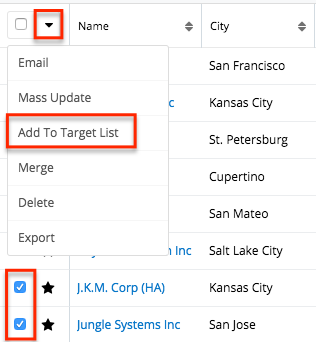
- Below the search bar, locate and select the desired target list in the dropdown list or click "Create new target list" to add the accounts to a new target list. Click "Update" to add the record(s) to the target list.

In order to view the accounts that have been added, you can navigate to the Target Lists module. Click the target list's name to open the record view, and you will see the account records within the Accounts subpanel. 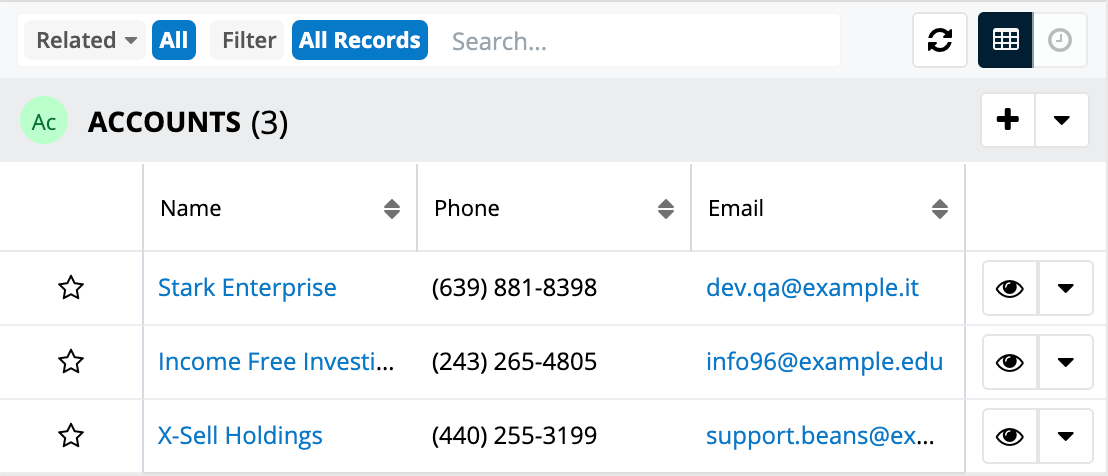
Campaign Log Subpanel
The Campaign Log subpanel contains historical information regarding an account's interaction with all Sugar campaigns. When a mass marketing campaign is sent to an account (or manually marked as sent in the case of non-email campaigns), the related campaign activity information will appear within the Campaign Log subpanel on the account's record view. This information mirrors the "View Status" page available from within each individual campaign and shows activities such as when a campaign was sent, when the recipient viewed the campaign message, when the recipient clicked a tracked link within the campaign, etc. Since this subpanel contains historical campaign interactions for the account, it cannot be used to associate an account with a campaign or otherwise manage a campaign or target list. For more information on associating an account with a campaign, please refer to the Adding to a Target List via Accounts List View section of this page. For more information on campaigns, please refer to the Campaigns documentation.
For more information on working with subpanels, please refer to the User Interface documentation.
Leads and Accounts
Once a lead has been evaluated and qualified, it can be converted into an account in addition to a contact and opportunity. Please note that Sugar automatically checks for any duplicate records in the system when converting the lead. The Convert Lead page will display any records that are detected as duplicates in a list view within the module panels (e.g., Account). You can either select the existing record or create a new record as necessary. For more information on lead conversion and creating new records, please refer to the Leads documentation.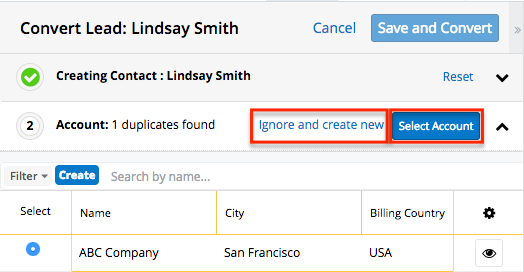
Creating via Lead Conversion
Sugar enables you to create a new account record during the lead conversion process. For more information about lead conversion, please refer to the Leads documentation.
Use the following steps to create an account during lead conversion:
- Navigate to a Leads record view.
- Select "Convert" from the Actions menu or click the Unconverted button to initiate the lead conversion process.

- If there are no duplicate records found for a module (e.g., Contacts) in lead conversion, the new record will be automatically marked for creation on the Convert Lead page and related to the lead. The panel will be collapsed as well, but you can click the header to open the panel and view the record's details.
- If there are duplicate records found for a module (e.g., Accounts), you can either select an existing account or create a new account record if none of the suggested duplicates are valid. Click "Ignore and create new" to create a new account record.
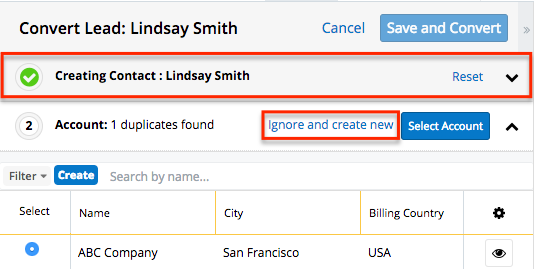
- Some of the fields (e.g., address, phone, etc.) on the displayed record view will be pre-populated with the lead's values. Simply update any necessary fields then click the Create Account button.
Note: You can click "Save and Convert" at the top of the page if you wish to convert the lead at this point. However, if you wish to create or relate an opportunity record to the lead as well, please complete the Opportunity panel on the Convert Lead page before saving and converting.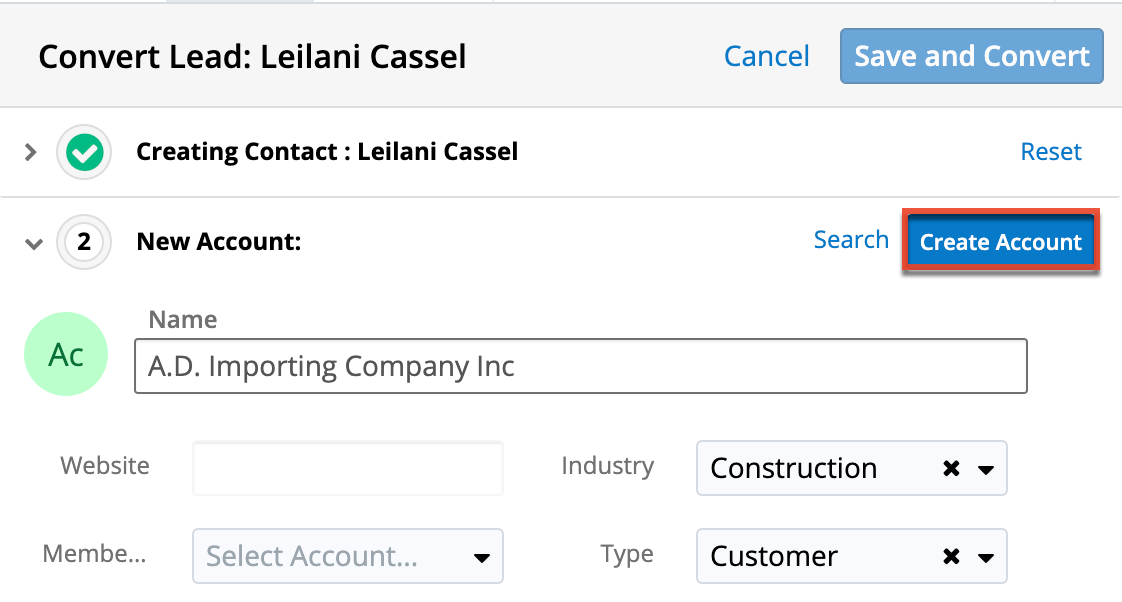
Once the lead has been converted successfully, the lead's record view will display the converted contact, account, and opportunity information below the record's detail. You can click the Preview icon to the far right of each record's row to view the details of the converted account and other records.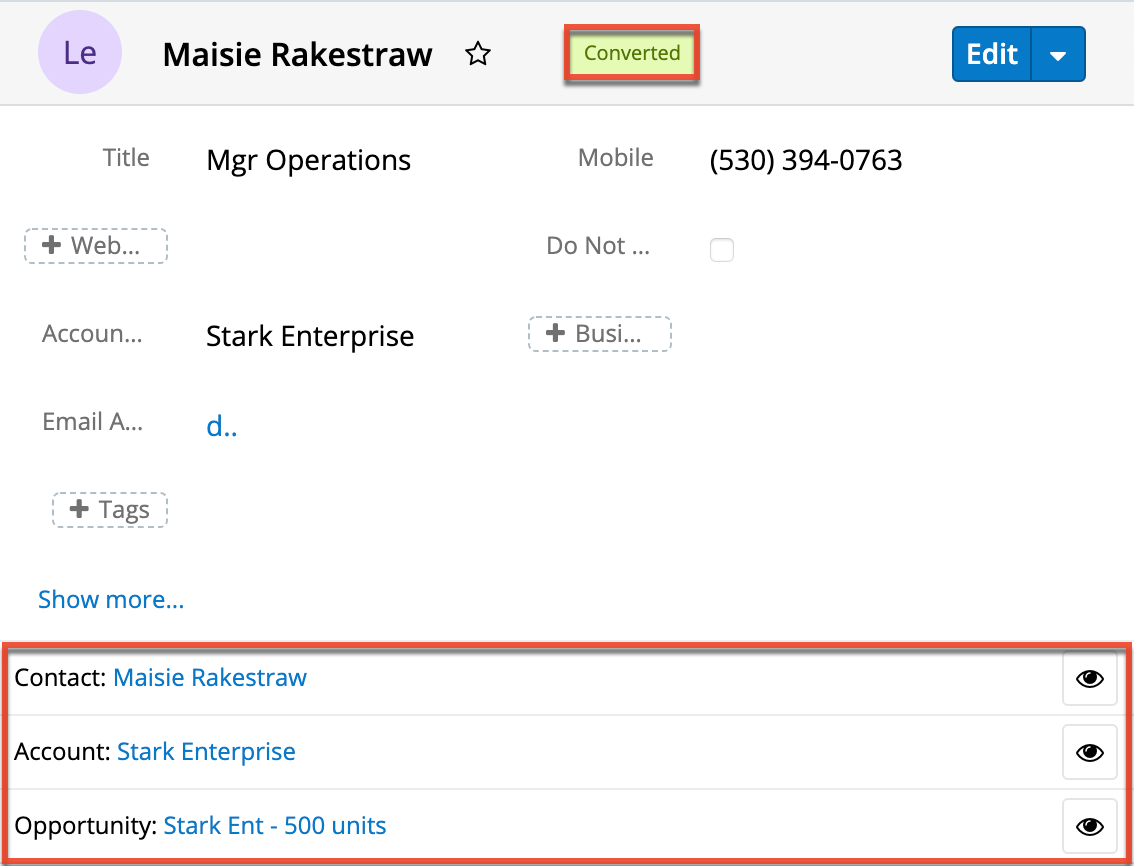
Working With Sugar Modules
While the Accounts module has some features that only apply to accounts, it also uses the Sidecar user interface that most Sugar modules are based on. The following sections detail menus, views, and actions common to Sidecar modules and contain links to additional information within the page or links to the User Interface documentation.
Account Menus
The Accounts module contains various options and functionality which are available via menus in the module tab, list view, and record view. The following sections present each menu and its options with links to more information about each option in the User Interface documentation or, for Accounts-specific functionality, within this page.
Module Tab Menus
Click the Accounts module tab in the navigation bar to access the Accounts list view. You may also click the three-dots menu in the Accounts module tab to display the Actions, Recently Viewed, and Favorites menus. The Actions menu allows you to perform important operations within the module. The Recently Viewed menu displays the list of accounts you most recently viewed. The Favorites menu displays the list of accounts you most recently marked as favorites. 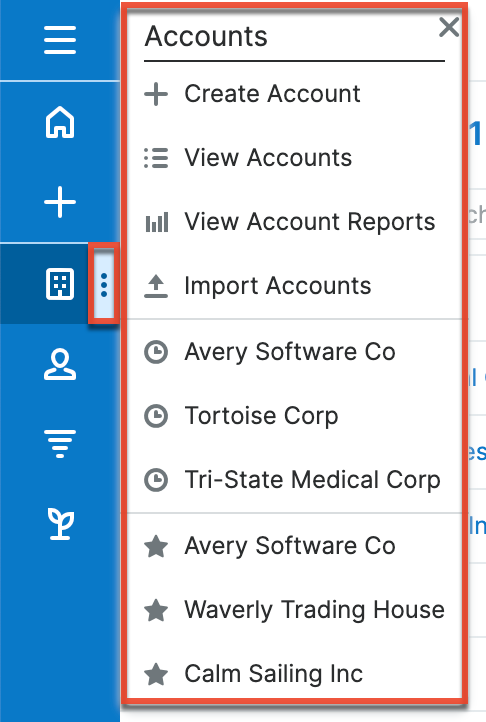
The module tab's Actions menu allows you to perform the following operations:
| Menu Item | Description |
| Create Account | Opens the record view layout to create a new account. |
| View Accounts | Opens the list view layout to search and display accounts. |
| View Account Reports | Displays existing reports based on the Accounts module. |
| Import Accounts | Opens the import wizard to create or update accounts using external data. |
For more information on module tab menus including reasons a module may not be included in the menu, see the User Interface documentation.
List View Menus
The Accounts list view displays all account records and allows for searching and filtering to locate specific accounts. You can view the basic details of each record within the field columns of the list view or click an account's name to open the record view. To access a module's list view, simply click the module's tab in the navigation bar.
List View Mass Actions Menu
The Mass Actions menu to the right of the checkbox option in the list header allows you to perform mass actions on all currently selected records. You can use the checkbox on each record's row to select individual account records or click the checkbox in the list header to select all records displayed on the current set of list view results.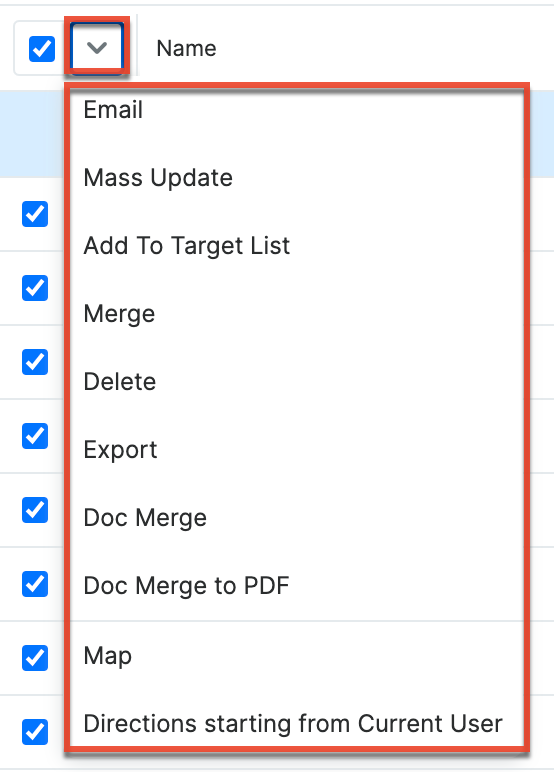
The Mass Actions menu allows you to perform the following operations:
| Menu Item | Description |
| Email one or more accounts at a time. | |
| Mass Update | Mass update one or more accounts at a time. |
| Add to Target List | Add one or more accounts to a target list. |
| Merge | Merge two or more duplicate accounts. |
| Delete | Delete one or more accounts at a time. |
| Export | Export one or more accounts to a CSV file. |
| Recalculate Values | Visible only if the module contains fields using Sugar Logic and only to System Administrators or users with Developer-level role access, this option will refresh the selected records' calculated values. |
| Doc Merge | Select or create a DOCX template to merge record data into documents that will be accessible in the Doc Merge widget. |
| Doc Merge to PDF | Select or create a DOCX, XLSX, or PPTX template to merge record data into PDF documents that will be accessible in the Doc Merge widget. |
| Map | For instances with Sugar Maps enabled, display this record or the selected records on a map. |
|
For instances with Sugar Maps enabled, plot driving directions on a map from your address to this record or all selected records. |
List View Record Actions Menu
The Record Actions menu to the far right of each record's row allows you to perform actions on the individual account directly from the list view.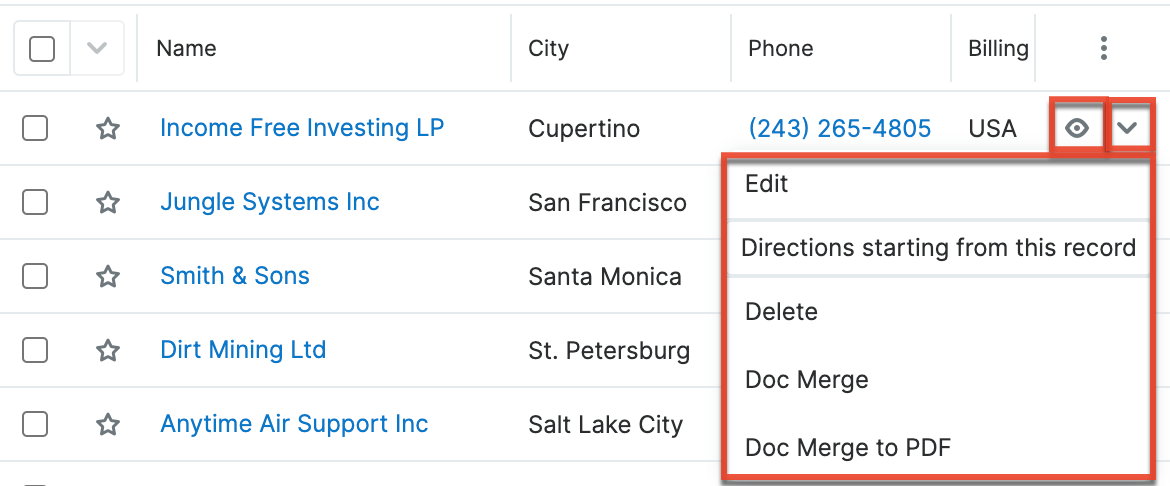
The list view's Record Actions menu allows you to perform the following operations:
| Menu Item | Description |
| Preview (Eye icon) | Preview this account in the intelligence pane. |
| Edit | Edit this account. |
| Follow | (Available if Activity Streams are enabled) Follow changes to this contact in your activity stream. |
| Directions starting from this record | For instances with Sugar Maps enabled, plot driving directions on a map from this record to another record or records. |
| Delete | Delete this account. |
| Doc Merge | Select or create a DOCX template to merge record data into documents that will be accessible in the Doc Merge widget. |
| Doc Merge to PDF | Select or create a DOCX, XLSX, or PPTX template to merge record data into PDF documents that will be accessible in the Doc Merge widget. |
Record View Actions Menu
The Accounts record view displays a single account in full detail including its fields, subpanels of related records, and activity stream. To access an account's record view, simply click a hyperlinked account name from anywhere within Sugar. The record view's Actions menu appears on the top right of the page and allows you to perform various operations on the current record.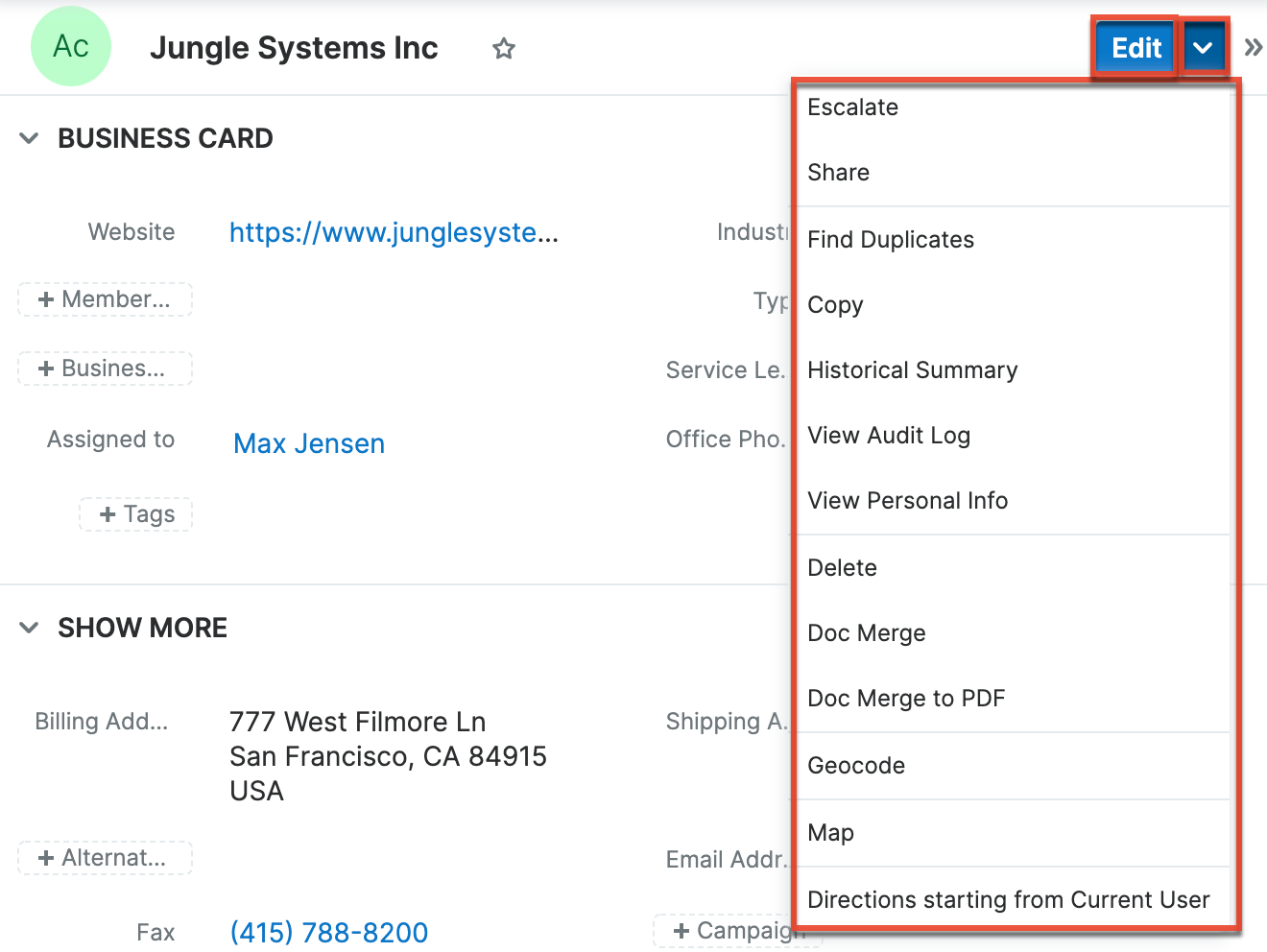
The Actions menu allows you to perform the following operations:
| Menu Item | Description |
| Edit | Edit this account. |
| Escalate | Create an escalation record related to the current record. |
| Share | Share a link to this account via email. |
| Download PDF |
Download the record's information as a PDF file.
|
| Email PDF |
Email the record's information as a PDF attachment.
Note: To send emails through Sugar, users must first configure a default user email account via Emails > Email Settings. |
| Find Duplicates | Locate potential duplicates of this account. |
| Copy | Duplicate this account to create a new account. |
| Historical Summary | View a historical summary of activities (e.g., calls, meetings, etc.) related to this account. |
| View Audit Log | View a record of changes to this account. |
| View Personal Info | Display this record's fields which an admin has designated as personal information. |
| Delete | Delete this account. |
| Doc Merge | Select or create a DOCX template to merge record data into documents that will be accessible in the Doc Merge widget. |
| Doc Merge to PDF | Select or create a DOCX, XLSX, or PPTX template to merge record data into PDF documents that will be accessible in the Doc Merge widget. |
| Geocode |
For instances with Sugar Maps enabled, manually set this record's location on a map. |
| Map |
For instances with Sugar Maps enabled, display this record or the selected records on a map. |
| Directions starting from Current User |
For instances with Sugar Maps enabled, plot driving directions on a map from your address to this record or all selected records. |
Common Views and Actions
In the table below, the left column contains links to the User Interface page covering topics that are applicable to all Sidecar modules. The right column has links to sections of the current page that cover topics specific to accounts.
| General Instructions for Working With Sugar Modules | Accounts-Specific Instructions |
| Use the links below to navigate to the User Interface page which covers topics generic to many Sugar modules. | When Accounts-specific help exists for each topic, use the links below to navigate to sections of the current page. |
| Creating Records | Creating via Lead Conversion |
| Viewing Records | |
| Searching for Records | |
| List View | List View Mass Actions Menu List View Record Actions Menu |
| Record View | Record View Actions Menu |
| Intelligence Pane | |
| Editing Records | |
| Deleting Records | |
| Emailing Records | Emails and Accounts Campaigns and Accounts |
| Exporting Records | |
| Recalculating Calculated Values | |
| Finding Duplicate Records | |
| Merging Records | |
| Viewing Record Historical Summaries | |
| Viewing Record Audit Logs | |
| Record PDFs | |
| Favoriting Records | |
| Following Records | |
| Sharing Records |